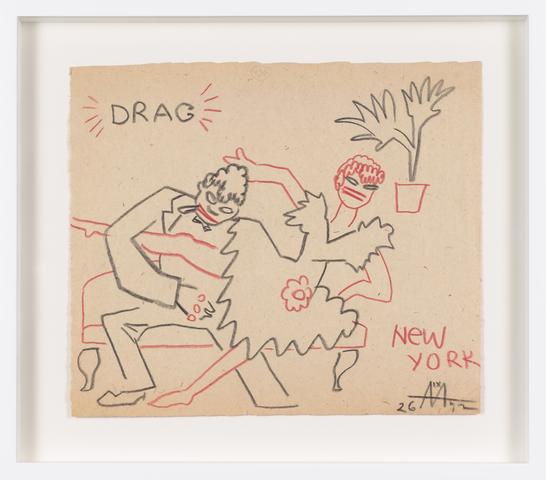세르게이 에이젠쉬타인 감독의 '섹스 드로잉'전
Sergei Eisenstein
Drawings 1931–1948
Alexander Gray Associates
러시아 무성영화시대의 거장 세르게이 에이젠쉬타인 감독의 에로틱 드로잉전이 1월 7일부터 2월 11일까지 첼시의 알렉산더 그레이 어쏘시에이츠 갤러리에서 열린다.

Alexander Gray Associates in collaboration with Matthew Stephenson presents a rare private collection of drawings by the Russian filmmaker and theorist, Sergei Eisenstein on view for the first time in the Americas. These sexually explicit drawings, completed between 1931–1948, span the period of his travels in Mexico and the United States in the 1930s until his death in Moscow in 1948.
A renowned film director and film montage innovator, Eisenstein also wrote extensively and made upwards of 5,000 drawings throughout his life, including designs for film sets and storyboards. This group, however, reveals Eisenstein’s sexual imagination, in part informed by his own bisexuality as well as his considerable reading and travel. Arranged in groupings that demonstrate a diversity of content, the drawings on view are intimately scaled, mostly monochromatic, with flashes of colored pencil typically in red or blue.
As historian Joan Neuberger notes, during his time in Mexico, “Eisenstein confirmed that drawing was no less important in his work as an artist than film-making and theory writing,” though it remains lesser-known. Many of his films are subtly subversive in his refusal to broadly prioritize propagandistic Soviet Realism over experimentation with camera techniques. In his “sex drawings,” Eisenstein engages in pointed institutional critiques, occasionally through the inclusion of Christian iconography and clergy members entwined in sexual acts that might be read as sacrilegious. He also illustrates figures engaged in intercourse in public spaces including the circus, nightclubs, and the streets. One red and black pencil drawing includes the text “Drag,” and features two figures in an environment that evokes a nightclub, likely in New York. One figure wearing a man’s suit appears to be reaching up the second figure’s dress as they recline on a sofa. Through his exploration of this content, Eisenstein constructs succinct and transgressive visual stories in a medium that was intentionally less public-facing than his films.
Also present in many of these drawings are irreverent depictions of inter-species relations including: a scene of matadors and bulls engaged in oral sex, and a fornicating alligator and rabbit captioned “Fucking, according to the Best System.” These pairings highlight Eisenstein’s fascination with dualities, which he called the “unity of opposites,” as well as his interest in representing a broad range of behaviors and desires reflecting the Freudian topicality of their time. Eisenstein’s experiences in Hollywood are apparent in these drawings, in particular his interest in Walt Disney’s films, which he claimed were “the greatest contribution of the American people to art,” and which informed his sometimes cartoonish style demonstrated in a drawing of a nude man draped backwards over an expressively wide-eyed giraffe.
After spending six months in California, Eisenstein traveled to Mexico to begin filming ¡Que Viva México!, an epic about the country’s history. He intended his trip to last three to four months; it lasted over a year. In 1946, Eisenstein wrote, “it was in Mexico that my drawing underwent an internal catharsis, striving for mathematical abstraction and purity of line. The effect was considerably enhanced when this abstract, ‘intellectualized’ line was used for drawing especially sensual relationships between human figures.” This interest in line and interplay of figures underscores his connection to the work of Mexican muralists including Diego Rivera, who Eisenstein first met in 1927, and whose work he greatly admired.
The drawings on view have a rich history. When departing Mexico, Eisenstein was stopped, questioned and his luggage searched at the United States border where the drawings were nearly confiscated for their incendiary nature. Upon his return to Moscow at the height of Stalin’s rule he kept the explicit images hidden until his death in 1948. His widow, the writer and filmmaker Pera Atasheva, donated most of his graphic archive, with the exception of his sex drawings, to the Russian State Archives of Literature and Art in Moscow (RGALI). Atasheva entrusted the erotic drawings to Eisenstein’s close friend and collaborator, the famous Soviet cinematographer Andrei Moskvin, who protected the director’s reputation by keeping these drawings hidden. After Moskvin’s death in 1961, his widow safeguarded the drawings. In the late 1990s her heirs sold the drawings to the family of present owner. A quarter of the drawings were also donated to the permanent collection of the State Hermitage Museum in St. Petersburg, Russia.
Also on view to provide visual context and connection to Eisenstein’s cinematic practice is a continual projection of the 1979 edit of ¡Que Viva México!, Eisenstein’s unfinished film which he began filming in Mexico in 1931. The film footage was edited by various people and released without Eisenstein’s participation in 1933, 1934, 1939,1940, and ultimately by his assistant director, Grigorii Alexandrov in 1979.
About Matthew Stephenson
Matthew Stephenson is a London based art dealer advising and representing artists and artist’s estates and assisting private collectors and institutions through the exhibition, acquisition and selling of 19th, 20th century and contemporary art.





